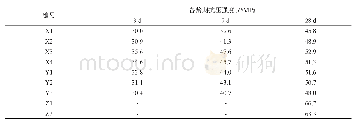《Table 3 Compressive strengths of concretes with montmorill-onite in the aggregate at different ages
 提示:宽带有限、当前游客访问压缩模式
提示:宽带有限、当前游客访问压缩模式
本系列图表出处文件名:随高清版一同展现
《Property and Degradation Characteristics of Concrete Prepared with Aggregate Contained Montmorillonite》
The compressive strengths of all concretes were tested after cured for1,3,28,and 56 d,respectively as shown in Table 3.It can be observed from the results that all concretes present a continuous strength increase in all ages.They are provided with the strength of about 4.3 MPa at 1 d and 16.3 MPa at 3d,respectively.Montmorillonite appearance does not pose any influence on the early concrete strength.However,the different case is observed after 28 d,and these concretes with montmorillonite in aggregate have the higher compressive strength than the control.It is well known that it has the absorbing water capacity.As the moisture content near the aggregate decrease in the cement hydration,and then it is lower than that in the aggregate.The absorbing water can be liberated from it and then it will alter the moisture condition in the harden cement paste.The hydration or reaction of unhydrated cementitious material will be promoted for the alteration of moisture condition.Especially,these concretes contain the fly ash and slag powder.Generally,the fly ash and slag powder hydrate or react slowly and a mass of them does not still hydrate or react at early ages.However,they will be hydrated or reacted at later ages while the curing is unceasingly carried out[20-22].Thus these concretes with montmorillonite in aggregate present a higher compressive strength at the later ages.This result implies that montmorillonite in aggregate can act as an inner curing role for the unhydrated cementitious material and facilitates their hydration or reaction at later ages.
| 图表编号 | XD0043327900 严禁用于非法目的 |
|---|---|
| 绘制时间 | 2019.02.01 |
| 作者 | 王艳伟、XU Chao、李好新 |
| 绘制单位 | China Railway No.9 Engineering Testing CO., Ltd、Key Laboratory of Advanced Civil Engineering Materials, Ministry of Education, Tongji University、School of Materials Science and Engineering, Tongji University、Key Laboratory of Advanced Civil Engineering Ma |
| 更多格式 | 高清、无水印(增值服务) |





